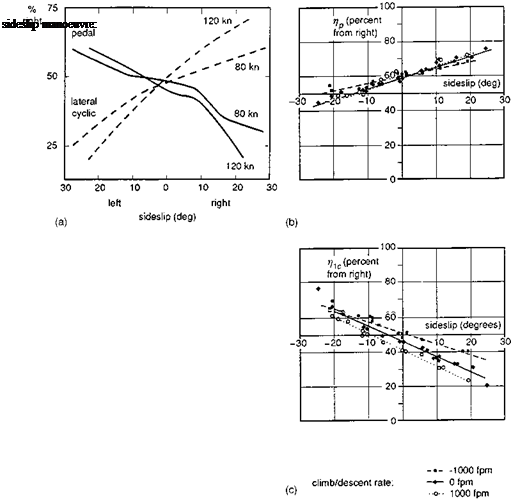Trim and quasi-static stability
A key flying qualities concern relates to the ability to trim a helicopter with adequate control margins remaining for manoeuvring, throughout the OFE. We have already discussed aspects of control adequacy in the section on control power but this can now be expanded in an examination of the roll axis. Just as with dynamic stability, however, it is difficult to discuss roll motion in isolation. The ease with which a pilot can coordinate entry to a turn, maintain trim in asymmetric flight or point the fuselage away from the direction of flight depends critically upon the ratio of two static stability effects, the yawing moment (Nv) and rolling moment (Lv) due to sideslip, i. e., directional and dihedral stability, respectively. ADS-33 requires the dihedral to be positive and essentially linear for Level 1 flying qualities. To protect against control limits being reached in sideslipping or sideways flight, upper limits on dihedral effects in the required MTEs are defined in terms of amount of control used, as follows:
Level 1: <75% control/49 N (11 lbf) control force;
Level 2: <90% control/60 N (13.5 lbf) control force.
Estimates of both the rolling and the yawing moments can be derived from steady heading sideslip flight tests at a range of forward speeds from climbing through to autorotative flight. Such tests will also highlight any control problems within the sideslip envelope which is usually defined from fuselage stress considerations as a piecewise linear function of airspeed. At each test point, control angles to trim and aircraft attitudes are recorded. Figures 6.38(a)-(c) illustrate trim control results for the Puma; Fig. 6.38(a) illustrates how the control gradients vary with forward speed while Figs 6.38(b) and 6.38(c) show results at three different flight states descent, level and climb at 100 knots, with the slopes of the curves again indicating directional and dihedral stability. The calculation of derivative ratios can be demonstrated using the analysis of Chapter 4. The following ratios can be derived from the steady moment balance in a
![]()
![]()
 |
(Lv L n pNv /Nr/p)
L V1c
8yP Nv
v Nn p where Snic and &np are the pilot’s control deflections from level trim and v is the sideslip velocity. Provided that the variation of the control derivatives with speed can be neglected, the trends, though not absolute variations, in dihedral and directional stability can therefore be derived. For helicopter configurations with a high set tail
rotor, the rolling moment from the tail rotor will contribute significantly to the lateral cyclic required in steady sideslipping flight. When the dihedral effect is small the trimmed cyclic may be in the same direction as the pedal trim, leading to Level 2 qualities according to ADS-33. An overriding pilot consideration when testing for directional and dihedral stability should be that clear unambiguous sideforce cues indicate the direction of sideslip. In particular, the pilot needs to be clearly alerted by these cues when sideslip limits are approached, as normally information on sideslip is not available to the pilot.













